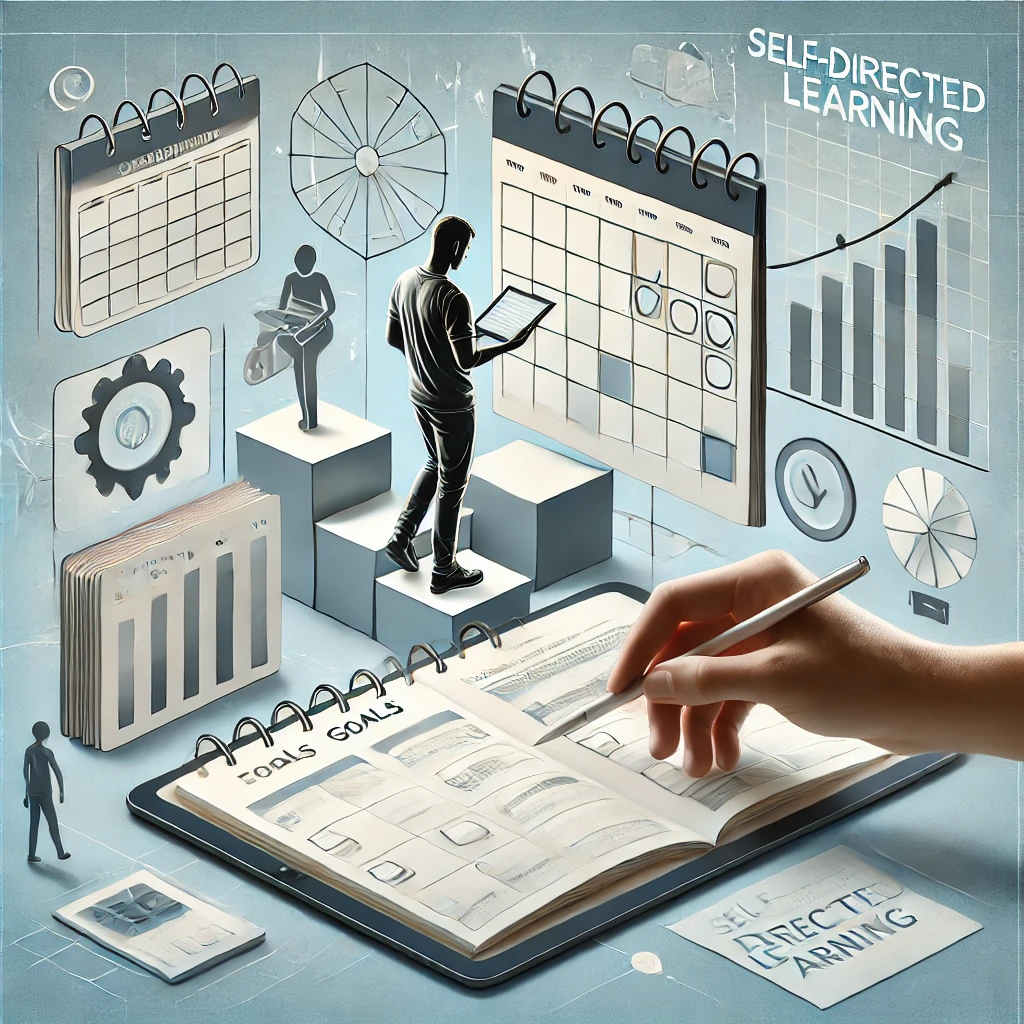Imagine being able to master any skill or topic at your own pace, without waiting for a formal class or course. Whether you want to learn a new software for work, dive into a side project, or stay ahead in your industry, self-directed learning (SDL) gives you the power to take control of your education. It’s a method that puts you in the driver’s seat—allowing you to tailor your learning experience to your needs and schedule.
In a world where information is more accessible than ever, self-directed learning is an essential skill for anyone committed to lifelong learning. This guide will show you how to create and follow your own curriculum, using proven strategies backed by research. By the end, you’ll have a practical framework for structuring your self-directed learning journey, and most importantly, making it stick.
In today’s fast-changing world, self-directed learning has become crucial for professionals and lifelong learners who want to stay ahead of the game. Whether you’re trying to pick up a new tech skill or dive deeper into a subject you love, creating and following your own curriculum can be both empowering and efficient.
In this guide, you’ll discover proven strategies to structure your self-directed learning journey. By the end, you’ll have the tools to design a curriculum that not only keeps you on track but also helps you learn faster and more effectively. Ready to take control of your learning? Let’s dive in!
Mastering Self-Regulation for Effective Learning
Have you ever started learning something new, only to lose steam after a few weeks? You’re not alone. The key to sticking with it lies in something called self-regulation. It’s like being your own teacher and student rolled into one.
Studies show that learners who can manage their time, set clear goals, and keep an eye on their progress are more likely to succeed. But what exactly is self-regulation, and how can you use it?
Self-regulation is all about setting goals, managing your time wisely, and keeping track of how you’re doing. It’s like having a personal coach in your head, cheering you on and helping you stay focused.
For busy professionals juggling multiple responsibilities, mastering self-regulation is a game-changer. It allows you to make steady progress in your learning, even when life gets hectic.
Here’s a practical way to put this into action: Set specific learning goals for each week, just like you would for a work project. Then, block out focused time for study in your calendar. Treat these learning sessions with the same importance as you would a crucial meeting.
“Self-regulation is the foundation of mastering any skill on your own terms.”
You can use digital tools like Trello or Asana to track your progress. Create a board for your learning project, add cards for each goal or task, and move them across columns as you make progress. It’s satisfying to see those cards move from “To Do” to “Done”!
Remember, self-regulation isn’t about being perfect. It’s about creating a system that works for you and helps you stay on track. With practice, it becomes second nature, making your self-directed learning journey much smoother.
Harnessing the Power of Reflection in Your Learning Journey
Have you ever finished a study session and wondered, “Did I really learn anything?” That’s where metacognition comes in. It’s a fancy word for a simple idea: thinking about your thinking.
Research shows that learners who regularly reflect on their learning strategies and make adjustments based on what works (and what doesn’t) can significantly improve their results. It’s like having a superpower for learning!
So, how can you use metacognition to boost your learning? It’s all about asking yourself the right questions and being honest with your answers. After you finish a study session or complete a module, take a moment to reflect:
- Did I fully understand this concept?
- What parts were easy? What parts were challenging?
- How can I approach this differently next time to understand it better?
By regularly asking yourself these questions, you’re training your brain to be more aware of your learning process. This awareness allows you to make smart adjustments to your study habits.
For example, let’s say you’re learning a new programming language. After a week of studying, you realize you’re struggling to remember the syntax. Your metacognitive reflection might lead you to try a different approach, like using flashcards or coding exercises, instead of just reading documentation.
“Reflect on your learning strategies regularly—it’s the key to continuous improvement.”
Here’s a practical tip: Keep a learning journal. After each study session, jot down what you learned, what was challenging, and any insights you had about your learning process. Over time, you’ll start to see patterns that can help you refine your learning strategies.
Remember, metacognition isn’t about being critical of yourself. It’s about being curious and open to improvement. By regularly reflecting on your learning, you’re setting yourself up for long-term success in your self-directed learning journey.

Using Technology to Build a Personalized Learning Path
In today’s digital age, we have powerful tools at our fingertips that can make self-directed learning easier and more effective. One of the most exciting developments is adaptive learning technology. It’s like having a smart tutor that adjusts to your needs in real-time.
Adaptive learning platforms use artificial intelligence to analyze your learning patterns. They then adjust the pace, difficulty, and focus of your lessons based on how you’re doing. It’s like having a custom-tailored learning experience!
For professionals looking to expand their skills, platforms like Coursera or LinkedIn Learning offer courses that adapt to your progress. They might suggest more challenging content if you’re breezing through lessons, or provide extra practice if you’re struggling with a concept.
Let’s look at a practical example. Say you’re using Duolingo to learn a new language for an upcoming business trip. The app tracks which words and grammar concepts you find tricky and gives you more practice in those areas. It also introduces new material at a pace that’s just right for you, keeping you challenged but not overwhelmed.
Or, if you’re diving into coding, platforms like Codecademy adjust their lessons based on your current knowledge and pace. This means you’re not wasting time on concepts you’ve already mastered, and you’re getting extra help where you need it most.
Here’s how you can make the most of these adaptive learning tools:
- Choose a platform that aligns with your learning goals.
- Take any initial assessments seriously – they help the platform understand your starting point.
- Engage consistently with the platform to allow it to learn your patterns and preferences.
- Don’t skip the harder parts – that’s where the real learning happens!
- Use the insights provided by the platform to understand your strengths and areas for improvement.
Remember, while these tools are powerful, they’re most effective when combined with your own self-regulation and metacognitive skills. Use them as part of your overall learning strategy, not as a replacement for your own effort and reflection.
By leveraging adaptive learning technologies, you’re not just learning – you’re learning smarter. You’re creating a personalized path that evolves with you, making your self-directed learning journey more efficient and effective.

Intrinsic Motivation: The Secret to Sustainable Learning
Have you ever found yourself completely absorbed in learning something, losing track of time because you were so interested? That’s intrinsic motivation at work, and it’s the secret sauce for successful self-directed learning.
Intrinsic motivation means you’re driven to learn by your own interest or enjoyment, not by external rewards like grades or certificates. Research shows that when learning aligns with personal passions or long-term goals, people are more likely to stick with it over time.
“Intrinsic motivation drives long-term commitment to learning.”
So, how can you tap into this powerful force? It’s all about connecting your learning to your personal or professional goals. Instead of thinking, “I have to learn this,” try shifting your mindset to, “I want to learn this because…”
For example, if you’re a marketing professional learning about data analytics, don’t just focus on completing a course. Instead, think about how these skills could help you create more effective campaigns or advance your career. This connection to your personal goals can turn a potentially dry subject into an exciting opportunity for growth.
Here’s a practical way to boost your intrinsic motivation: Create a learning project that directly relates to something you’re passionate about. Let’s say you’re learning graphic design. Instead of just working through tutorials, set a goal to design a logo for a side business you’ve been dreaming about. This approach makes your learning immediately relevant and exciting.
Remember, intrinsic motivation doesn’t mean every moment of learning will be fun or easy. There will still be challenges and moments of frustration. But when you’re driven by internal goals and interests, you’re more likely to push through these tough spots.
To keep your intrinsic motivation strong:
- Regularly remind yourself why you’re learning this skill or subject.
- Celebrate small wins along the way – each bit of progress is moving you towards your bigger goals.
- Find ways to apply what you’re learning in real-life situations, even if they’re small.
- Connect with others who share your interests – their enthusiasm can be contagious!
- Allow yourself to explore related topics that pique your curiosity.
By tapping into your intrinsic motivation, you’re not just making learning easier – you’re making it a natural, enjoyable part of your life. And that’s the key to becoming a successful, lifelong self-directed learner.

Putting It All Together: Your Action Plan for Self-Directed Learning
Now that we’ve explored the key elements of successful self-directed learning, it’s time to put it all into action. Here’s a step-by-step plan to help you create your own personalized learning curriculum:
- Create a Learning Plan with Defined Milestones Start by identifying your end goal. What do you want to achieve? Then, work backward to break this big goal into smaller, manageable tasks. For example, if your goal is to create a website, your milestones might include learning HTML, then CSS, then JavaScript, and finally, putting it all together in a project.
- Adopt a Time-Blocking Strategy Look at your weekly schedule and carve out specific time slots for learning. Treat these as important as any work meeting. Even if it’s just 30 minutes a day, consistency is key. Put these learning blocks in your calendar and stick to them.
- Use Reflection to Continuously Improve At the end of each week, take a few minutes to review your progress. Ask yourself:
- What did I learn this week?
- What worked well in my learning approach?
- What challenges did I face?
- How can I improve next week?
Use these insights to adjust your learning strategies as needed.
- Integrate Microlearning into Your Routine Break your learning into small, bite-sized chunks. Use apps or platforms that offer short lessons you can complete in 5-10 minutes. This makes it easier to learn consistently, even on busy days. You might listen to a podcast during your commute or do a quick coding exercise during your lunch break.
- Join Learning Communities for Feedback and Support Find online forums, local meetups, or study groups related to what you’re learning. Share your progress, ask questions, and offer help to others. This community support can boost your motivation and provide valuable feedback on your learning journey.
Remember, your learning plan should be flexible. As you progress, you might need to adjust your goals or strategies. That’s not just okay – it’s a sign that you’re growing and becoming more aware of your learning needs.
Conclusion: Your Learning Journey Starts Now
We’ve covered a lot of ground in this guide to self-directed learning. From mastering self-regulation and harnessing the power of reflection, to using technology and tapping into your intrinsic motivation, you now have a toolkit for creating and following your own curriculum.
Remember, the key points we’ve discussed:
- Self-regulation helps you stay on track and make steady progress.
- Metacognition allows you to reflect on and improve your learning strategies.
- Adaptive learning technologies can personalize your learning experience.
- Intrinsic motivation is the driving force for sustainable learning.
Now, it’s time for action. Your first step? Create your personalized learning blueprint. Take a moment to reflect on your goals, choose the tools that suit your style, and map out a curriculum that aligns with your ambitions.
Don’t worry about making it perfect from the start. The beauty of self-directed learning is that you can adjust and improve as you go. The most important thing is to begin.
So, what will you learn first? What small step can you take today to start your self-directed learning journey? Remember, every expert was once a beginner. Your journey to mastery starts with that first step.
Happy learning!
